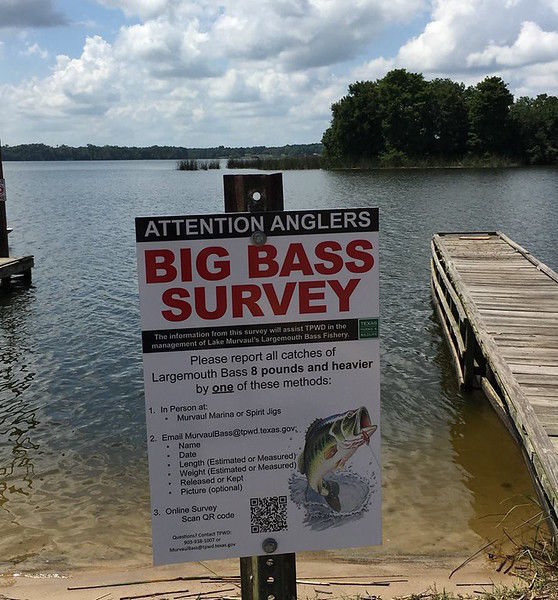Big Time
Published 7:16 am Friday, July 14, 2017

- tpwd/COURTESY TPWD has installed signs at Lake Murvaul asking fishermen to participate in a trophy bass survey. Information on big fish will aid in management of the lake, including a stocking schedule.
In the 1990s, Lake Murvaul was a special gem of East Texas trophy bass fishing. Between 1987 and 1997 the 3,400-acre lake west of Carthage produced six ShareLunker bass 13 pounds and greater, the largest being a lake record 14.88.
The lake is one of 16 in the state that has produced five or more ShareLunkers, and one of six under 5,000 acres with that many. The other five are 2,880-acre Lake Alan Henry south of Lubbock with an amazing 27; Lake Austin, 1,559 acres, with 20; 610-acre Baylor Creek Reservoir near Childress with 5; Lake Casa Blanca, 1,680 acres, near Laredo with six; and Gibbon Creek, 2,770 acres, with five.
Trending
Constructed in 1958 during Texas’ lake building era, Lake Murvaul has long been known as a good bass fishery to the locals.
From the beginning, the lake had a reputation of producing big bass, and was especially known for its unusually big male bass. That quality was enhanced early in the state’s Florida bass era, even though Murvaul was only lightly stocked with Florida strain bass throughout the 1980s.
Prior to 1997, the lake had received a total of 386 adult Florida bass and just 200 fingerlings. The ShareLunker website indicates fish caught in 1993, 1994 and 1997 were Florida/native crosses, an indication they could have been the offspring of some of those adult stockings.
“It was probably an ideal mix of introducing Florida largemouth genetics, abundant vegetation and lower angling pressure that allowed Murvaul to produce its run of ShareLunkers,” said Joseph Lechelt, TPWD Inland Fisheries biologist from Marshall
In an effort to learn more about the lake today, TPWD has begun a fisherman survey seeking information on trophy bass catches.
“This is a volunteer angler survey, similar to the one conducted on Lake Fork from 2003 to 2013. We are asking anglers to report all catches of bass 8 pounds or heavier,” Lechelt said.
Trending
Signs announcing the survey were recently installed at the lake. Lechelt said there is no timeframe for the length of the survey, but that the longer it runs the more information biologists gather on the fishery.
“As far as the length of the survey, there is no definitive end date. I would say if the survey went three to five years that would be great and longer if possible. It all depends on angler participation and the quality of the information that we are receiving from the survey. We are hoping that we can maintain and increase interest in the survey with our Facebook posts, emails and other public involvement,” Lechelt said.
The biologist said the survey is not about change so much as it is to help gather information on the lake’s fishery. It will provide biologists information on bass health through length/weight information.
Maybe more importantly is that the frequency in which bass over 8 pounds are caught is one of the justifications used by the department in determining future stockings of Florida largemouth bass.
“The information from this survey will be used to help develop our management plan going forward and justify our current management strategy of stocking Florida largemouth bass every other year,” Lechelt said.
While knowing about the big bass is important criteria in fisheries management, biologists typically have a hard time recording bigger fish with normal surveying techniques.
“The biological goal of this survey is to gather information on largemouth bass greater than 8 pounds in Lake Murvaul. Traditionally, bass this size are difficult to capture through electrofishing, which is our standard sampling method for largemouth bass,” Lechelt explained.
There are other questions the survey can answer just from a fisherman standpoint.
“While there has not been another ShareLunker produced since 1997, Lake Murvaul is still regarded as a high quality bass fishery and we are hoping that this survey further bolsters that point. It is not known for certain why Lake Murvaul has not produced another ShareLunker since that time, but it’s likely a result of the dramatic change in vegetation abundance,” Lechelt said.
The biologist said one reason for the big fish drought could very well be not just a change but an almost complete disappearance of vegetation.
In 1997, more than a quarter of Murvaul was covered with hydrilla. Lechelt said that while hydrilla is an invasive species, its edges and holes can also provide cover for spawning fish and feeding areas.
Following a drought in 2005, the hydrilla disappeared and now is almost non-existent on the lake. What has shown up has been water hyacinth and giant salvania, two other serious invasive species that have required herbicide spraying, thus reducing vegetation even more.
“This reduction in habitat may be limiting the potential of Lake Murvaul’s bass to grow to ShareLunker size,” Lechelt said.
At the same time, fishing pressure has almost doubled since 2009, with most of it coming from area fishermen.
Fishermen catching 8-pound and larger bass can report their catch in three ways – at the lake at Murvaul Marina or Spirit Jigs, by email to MurvaulBass@tpwd .texas.gov with their name, date, length of the bass, weight of the bass, kept or released, and a picture, or by scanning the QR code on the signs at any boat ramp and filling out a brief survey.
Lechelt said participating fishermen that provide an email address will be added to a list that will receive periodic updates on the survey.
Have a comment or opinion on this story? Contact outdoor writer Steve Knight by email at outdoor@tylerpaper.com. Follow Steve on Facebook at Texas AllOutdoors.






